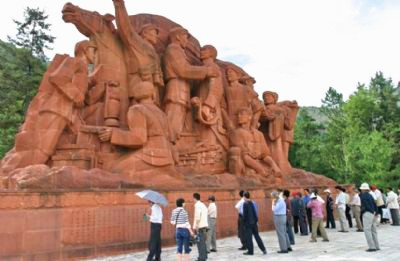
Shuicheng Arms Expansion Site of The Red Army in Huize County, Qujing
Introduction
Shuicheng Arms Expansion Site of The Red Army in Huize County (会泽水城红军扩军旧址) is a classic site for red tourism in China. Located in the outskirts of Huize County (会泽县) in Qujing City (曲靖市), this site commemorates a significant historical event that took place during the Long March (长征) in 1935, when the First Front Army of the Chinese Workers’ and Peasants’ Red Army (中国工农红军第一方面军) expanded its ranks by over 1,300 soldiers, raising funds of 100,000 silver dollars to support the Central Red Army’s successful arrival in Shaanxi (陕北).
The site is recognized as one of Yunnan’s top ten red tourism attractions and was opened to visitors in 2002. Covering an area of 300,000 square meters, the site features more than 3,500 ancient pear trees, some over a century old. The park integrates red culture, Yelang culture, and the culture of the indigenous Yi ethnic group, divided into five main areas: Red Culture Education Area, Historical Exhibit Area, Agritainment Area, Pear Orchard Area, and Ancient Tomb Archaeological Area.
Site Features
The Shuicheng Red Cultural Ecological Park (水城扩红文化生态园), located 2 kilometers northwest of Huize County, is constructed according to national 4A tourist attraction standards. It serves as a revolutionary patriotism education base and a national defense education base. It is one of seven sites in Yunnan recognized as classic red tourism sites.
The site is not only an important historical landmark but also a bearer of rich red culture and revolutionary history. In May 1935, the Ninth Corps of the Central Red Army expanded its ranks by over 1,500 soldiers here, marking the largest recruitment during their Long March. On May 4, the newly recruited soldiers were organized into a new regiment at the Shuicheng Pear Orchard, led by Liu Xiongwu (刘雄武) and mobilized by corps commander Luo Binghui (罗炳辉).
The park includes the expansion site, a large sculpture called “Wumeng Pangbo” (乌蒙磅礴), the Huize Revolutionary History Memorial Hall (会泽革命历史纪念馆), ancient tombs, and an ancient pear orchard. Climbing 188 steps from the memorial platform to the square allows visitors to view the “Wumeng Pangbo” sculpture, which depicts the touching scenes of recruitment and the deep bond between the army and the people.
Cultural Significance
The park integrates red culture, Yelang culture, and indigenous Yi (彝族) culture. It is divided into five main areas:
- Red Culture Education Area
- Historical Exhibit Area
- Farm Stay Activity Area
- Pear Orchard and Flower Area
- Ancient Tomb Historical Research Area
Historical Context
From October 1934 to October 1935, the main force of the Central Red Army embarked on a year-long journey filled with difficulties, traversing 11 provinces and engaging in over 380 battles during the Long March (长征). This journey laid a solid foundation for the Chinese revolution.
On May 1, 1935, the Red Ninth Corps was warmly welcomed upon arriving in Huize and organized a public meeting to promote the Communist Party’s policies and the Red Army’s northward campaign against Japanese aggression.
On May 4, under the leadership of Corps Commander Luo Binghui (罗炳辉) and Political Commissioner He Changgong (何长工), the Corps formed a new battalion of soldiers from local recruits in the Shuicheng pear orchard.
Features of the Park
The Shuicheng Expansion Cultural Ecological Park consists of:
- The Red Army Expansion Memorial Platform
- The “Wumeng Pangbo” (乌蒙磅礴) Large Group Sculpture
- The Huize Revolutionary History Memorial Hall
- The Ancient Tombs of Shuicheng
- The Ancient Pear Tree Garden
Visitors can climb 188 steps from the memorial square to see the impressive “Wumeng Pangbo” sculpture, which vividly depicts scenes of the expansion and the deep bond between the military and the people.
Historical Background
During the Long March from October 1934 to October 1935, the main force of the Central Red Army traveled through 11 provinces, including Fujian (福建), Jiangxi (江西), Guangdong (广东), Hunan (湖南), Guangxi (广西), Guizhou (贵州), Sichuan (四川), Yunnan (云南), Xikang (西康), Gansu (甘肃), and Shaanxi (陕西), capturing 62 cities and engaging in over 380 battles. This journey solidified the foundation for the Chinese revolution’s future victories.
In late April 1935, the Ninth Corps, led by Luo Binghui, He Changgong (何长工), Guo Tianmin (郭天民), and Huang Huaqing (黄火青), executed strategic maneuvers in the Ujiang River area before moving toward Huize. On May 1, they were warmly welcomed by the local population and conducted a mass meeting to promote the Communist Party’s policies.
The following days saw intense military action, culminating in the successful recruitment of 1,500 local residents into the Red Army. This recruitment effort is celebrated as a significant moment in the history of the Red Army’s expansion during the Long March.
Travel Information
How to Get There
- By Car: The site is approximately 223 kilometers from Kunming (昆明). Drive from Kunming to Songming (嵩明), take the Songming-Daihu (嵩待) Expressway, and continue towards Huize on National Highway 50.
- Public Transport: Consider taking a bus from Kunming to Qujing and then another to Huize.
Travel Tips
- Operating Hours: Open daily from 9:00 AM to 9:00 PM.
- Admission: Free entry.
- Best Time to Visit: The region has a subtropical monsoon climate, making it suitable for travel year-round with mild summers and winters.
- Nearby Attractions: Explore Huize Ancient Town (会泽古城), Dahuicaoshan Scenic Area (大海草山风景区), Jinzhong Mountain (金钟山), and Wenbi Tower (文笔塔).
- Dining Options: Enjoy local delicacies like fried potatoes (炸洋芋), beef and mutton hotpot (牛汤锅羊汤锅), and rainbow trout (虹鳟鱼).
- Accommodation: Numerous hotels are available near the expressway exit.
This site not only commemorates a crucial moment in Chinese history but also serves as a vibrant cultural destination, embodying the spirit of patriotism and the legacy of the Red Army.


 7 Days GolfingTour
7 Days GolfingTour
 8 Days Group Tour
8 Days Group Tour
 8 Days Yunnan Tour
8 Days Yunnan Tour
 7 Days Shangri La Hiking
7 Days Shangri La Hiking
 11 Days Yunnan Tour
11 Days Yunnan Tour
 6 Days Yuanyang Terraces
6 Days Yuanyang Terraces
 11 Days Yunnan Tour
11 Days Yunnan Tour
 8 Days South Yunnan
8 Days South Yunnan
 7 Days Tea Tour
7 Days Tea Tour
 8 Days Muslim Tour
8 Days Muslim Tour
 12 Days Self-Driving
12 Days Self-Driving
 4 Days Haba Climbing
4 Days Haba Climbing
 Tiger Leaping Gorge
Tiger Leaping Gorge
 Stone Forest
Stone Forest
 Yunnan-Tibet
Yunnan-Tibet
 Hani Rice Terraces
Hani Rice Terraces
 Kunming
Kunming
 Lijiang
Lijiang
 Shangri-la
Shangri-la
 Dali
Dali
 XishuangBanna
XishuangBanna
 Honghe
Honghe
 Kunming
Kunming
 Lijiang
Lijiang
 Shangri-la
Shangri-la
 Yuanyang Rice Terraces
Yuanyang Rice Terraces
 Nujiang
Nujiang
 XishuangBanna
XishuangBanna
 Spring City Golf
Spring City Golf
 Snow Mountain Golf
Snow Mountain Golf
 Stone Mountain Golf
Stone Mountain Golf



















